In the year 2505, the United States is populated entirely by idiots. Even the president has an IQ that doesn’t surpass 100. This is the world depicted in the movie <Idiocracy, 2006>. ‘Idiocracy’ is a portmanteau of ‘idiot’ and ‘cracy,’ implying a government or rule by idiots.
One might wonder how, in 500 years, with the tremendous advancements in information and science, people could have devolved into such a state, contrary to what one might expect of an era more intelligent than ours. The movie’s poster, featuring a character with a belly protruding out while holding a remote control, beer can, joystick, and wine bottle, quite unlike the balanced physique of Da Vinci’s Vitruvian Man, explains the reasons well. Joe Bauers (played by Luke Wilson), the protagonist of <Idiocracy>, wants to convey the following message to the people of today, who prefer not to think:
Joe Bauers: Tell people to read books. Tell them to stay in school. Tell people to just use their brains or something.

English sentences typically start with the subject followed by the verb, crafting a structure that caters to our innate curiosity. The usual sequence involves a person, then an object or action, followed by the location, the reason, the method, and finally, the timing. This sequence is a key feature of how English is structured for clear communication.
Take the example “I like~”. This phrase sparks curiosity about the subject’s interest. Although ‘what’ is generally referred to as ‘object’, it includes actions and behaviors as well. For a clearer expression of desire, such as wanting to watch TV, it’s more precise to say “I like to watch TV” instead of the broader “I like TV”.
The command “Tell people to read books” effectively clarifies who should do what, addressing the ‘who’ and ‘what’ directly. This showcases how English allows for straightforward instructions or expressions of desire.
want-type verbs.
In the film Five Easy Pieces, a notable exchange between Jack Nicholson’s character and a waitress exemplifies this:
WAITRESS: “You want me to hold the chicken, huh?”
BOBBY DUPEA: “I want you to hold it between your knees.”
This type of verb typically has meanings such as “[someone wants or expects something to happen].” The main verbs belonging to this category include want, wish, need, like, intend, expect, allow, ask, cause, compel, forbid, permit, urge, warn, etc.
Let’s look at some examples as mentioned before:
God: “People want me to do everything for them. What they don’t realize is that they have the power. You want to see a miracle? Be the miracle.” <Bruce Almighty>
PHILIP MARLOWE: “I’m not crazy about yours. I didn’t ask to see you.” <THE BIG SLEEP, 1946>
In the quote above, “I didn’t ask to see you” can be understood as a shortened form of “I didn’t ask you to see you,” meaning I did not request to meet you. Here’s what a demanding boss says:
Bill Lumbergh: “Oh, oh, and I almost forgot. Ahh, I’m also gonna need you to go ahead and come in on Sunday, too.” <Office Space 1999>
Let-type Verbs
Similar to the verbs of the ‘want’ type mentioned above, some verbs allow the omission of ‘to’ in the infinitive form. The following lines exemplify such a case.
AGENT J: “You know the difference between you and me? I make this look good.”<Men in Black, 1997>
Although it has been mentioned before, English sentences should always contain only one verb. However, as seen in “make this look good,” two verbs appear together. This is possible because the verb ‘look’ in the example is not just a verb but rather a disguised form of the infinitive ‘to look’, functioning as an adjective here, with ‘to’ omitted.
Verbs like have, make, let, bid, known as causative verbs in grammar books, can omit ‘to’. Causative verbs mean verbs that cause the object to ‘do something’.
John Keating: “Oh, that’s excellent! Now, give him action – make him do something!” <Dead Poets Society>
Lucy: “I need to go to the bathroom. Daddy! Daddy! She said we could go to the park.” Sam: “What happened? What made her change her mind?” (I am Sam)
Let’s also listen to the dialogue between Jack Nicholson and his co-star Helen Hunt in <As Good As It Gets>, as well as words from General George Patton.
Melvin: “My compliment is that when you came to my house that time and told me how you’d never, well, you were there, you know. The next morning I started taking these pills.”
Carol: “I don’t quite get how that’s a compliment for me.”
Melvin: “You make me want to be a better man.”
Carol: “That’s maybe the best compliment of my life.” <AS GOOD AS IT GETS, 1997>
GEN. GEORGE PATTON: Now, I want you to remember that no bastard ever won a war by dying for his country. He won it by making the other poor dumb bastard die for his country. <PATTON, 1970>


답글 남기기